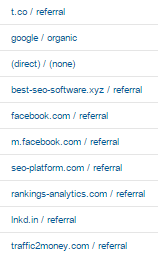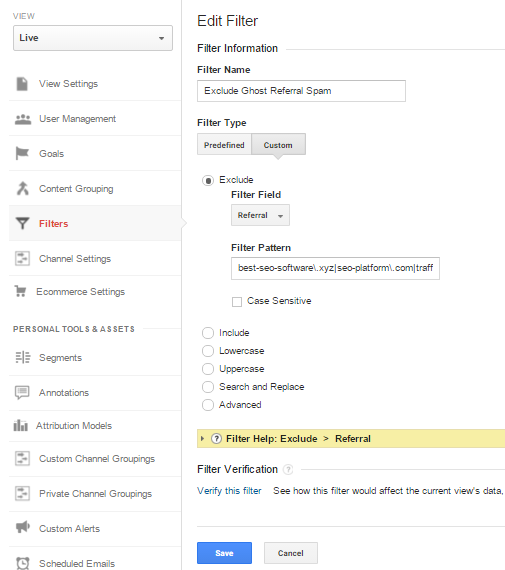
If you’re like me and diligent in your use of Google Analytics (here’s how by the way), you may have noticed some odd referring sources creeping in to your data. In honor of my favorite holiday sneeking up on us, let’s talk about ghosts.
Article Highlights
Ghost Traffic & Ghost Referral Spam
Ever the mission of the diligent spammer, questionable marketers and business owners will forever push email and other forms of spam in our face. The latest of these techniques gets the attention of website owners who desperately want “SEO,” “Traffic,” and “Rankings” but lack understanding of the fact that 3rd party services can’t simply manifest such results (growth isn’t that easy friends). They get your attention by spamming Google Analytics.
Truly, they spam your data. How on earth does such a thing work??
 Businesses that use Google Analytics regularly refer to a few reports, among the limitless insights available therein. One of those reports shows the business the source of traffic to their site; traffic “referred” by other websites. This is called referred traffic and shows up in the Acquisition > All Traffic > Source/Medium report, most prominently, if you’re following along. A snippet of the data looks like what I’ve shown to the right; that is, from where traffic comes: Google, Facebook, t.co (which is Twitter) are all there.
Businesses that use Google Analytics regularly refer to a few reports, among the limitless insights available therein. One of those reports shows the business the source of traffic to their site; traffic “referred” by other websites. This is called referred traffic and shows up in the Acquisition > All Traffic > Source/Medium report, most prominently, if you’re following along. A snippet of the data looks like what I’ve shown to the right; that is, from where traffic comes: Google, Facebook, t.co (which is Twitter) are all there.
One of the first insights you, as a business, should have, Analytics’ Source/Medium report tells you from where your audience is coming. Thus, which sites are promoting you and relatively, how much so. It provides wonderful insight to fans who might have blogged about you, whether Twitter or LinkedIn is a more popular social network to your customers, and how extensively.
What then might an enterprising spammer do? Refer a bunch of visitors to your site so their URL shows up as someone sending significant amounts of traffic to you. Take a look again at the screenshot and notice best-seo-software.xyz, seo-platform.com, rankings-analytics.com, and traffic2money.com. That is ghost traffic. Referral spam.
What to do about Ghost Referral Spam
That business owner or startup founder desperately seeking more traffic may look at that data (so hopes the spammer) and thrilled that they are sending traffic to the business, over to that referring URL they go. And the spammer has you. Seeking a better position in Google, over to rankings-analytics.com I go, after all, they’re promoting me so why wouldn’t I check them out?
Except they aren’t promoting you.
These spammers are sending ghosts to your site. They’re getting your attention by making you think their site is referring people to you when in fact it’s nothing more than the Spirit of Unique Users haunting your domain.
Need you be concerned? No. Unless the amount of referral spam you receive is so great that you’ve been making business decisions influenced by ghosts, the illegitimate traffic is of no harm to your site. So let’s clean up your data by filtering these spammers out.
 Head to your Google Analytics account and visit the Admin settings. There, under View on the right, click Filters to Add Filter.
Head to your Google Analytics account and visit the Admin settings. There, under View on the right, click Filters to Add Filter.
We’re going to set up a Custom filter that excludes from your Analytics all the sites that are referring ghost traffic. It’s a little easier to show than tell so take a look at my screenshot.
- Name your filter something you’ll remember, “Exclude Ghost Referral Spam” makes sense but you might prefer, “Filter the asshats who are screwing with my business by spamming me.”
- Select Custom > Exclude > and under Filter Field set your options to Referral to remove from Google Analytics the referral traffic we’re about to set.
- Under Filter Pattern you’re going to add each URL you want removed but it has to be written in a particular way: best-seo-software\.xyz with the backslash.
- To list more than one site you want removed, you use a pipe | between them like this: best-seo-software\.xyz|seo-platform\.com
To make it handy, here is the Filter Pattern I routinely add to every company with which I work, to immediately filter the usual suspects. Go ahead and copy/paste this as a starting point:
best-seo-software\.xyz|seo-platform\.com|traffic2money\.com|megalytic\.com|blog\.megalytic\.com|old\.megalytic\.com|forums\.megalytic\.com|client\.meglytic.com| buttons-for-website\.com|support\.megalytic\.com|semalt\.com
You need not fill out anything else. Click Save and the filter is in place.
Note, it does NOT work retroactively so historically speaking you’ll continue to see the offending data. To be sure your ghost busting has worked, look again tomorrow and all of the traffic from traffic2money.com will be gone.
Why it’s Important to Filter Ghost Traffic
Before you head of to trick or treat, you may be saying to yourself bah, ghosts aren’t real, this doesn’t matter much. Let me encourage you to put this filter in place even if you don’t see Ghost Spam today.
While this traffic isn’t real, as far as your data is concerned, it is. That means Analytics is accounting for visitors that aren’t going to do anything. Your intelligence can be drastically skewed to account for these “people” who don’t spend time on the site, don’t consume page views, don’t register, and can’t buy. Your conversion rate will be reported as lower than is actually the case and you’ll be making business decisions predicated on information that isn’t accurate. Clean it up, good luck, and as always let me know if I can help.



I’ve wondered why google doesn’t do something about these guys. They not making a difference on any one website, but they have got to be messing up or hacking google analytics. They have to be using up google’s bandwidth on a global scale. Do you know if google has addressed this issue?
Well in fairness to Google Laura, I actually like to think Google intentionally does not do anything about it. The magic of Google, I hope they agree, is that it doesn’t discern. It weights, but it doesn’t decide what we can and can not discover. Everything indexed, the deep web, porn, horrific videos, and more, Google’s lives up to their mission of indexing the world’s information and making it available – it’s up to us to decide what’s preferred. Of course, we could argue how well they live up to that but the sentiment makes sense in this regard: why doesn’t Google automatically filter spammers from Analytics?
Who’s going to decide who is actually only spamming? Is the fact that your site is getting spammed not a data point? Granted, not a terribly valuable one but new sites don’t get spammed so you must have achieved something 🙂 Or another way to look at it is my point that you can’t just buy rank, position, SEO. That’s a BS belief perpetuated by scam consultants and agencies who continue to proclaim it’s possible. Consider that Google doesn’t care to deal with it because it’s a data point for THEM; a way for them to identify which websites and companies are actually trying to do that…. enabling people to buy their way into Google is a way for them to identify and penalize those who try.
I’ve had some relief using htaccess. I also make sure to check the item in settings to remove hits from known bits and spiders.
Thanks for sharing this. I’ve been noticing a lot of this traffic.
No Pj I don’t. Bounce is the metric that matters in the sense that its a bounce back to Google, after coming from Google. As such it simply measures that the search result was poor (so don’t show it as prominently). To my knowledge, a bounce from a referral, legitimate source or not, doesn’t factor at all.
Paul O’Brien do you believe in 2015 that Google sees these bots bringing 100% bounce rates and 0 second sessions and factors that into search rankings?
I filter all of them out of my Google Analytics as I’m setting up a new site and I need real data. All that fake data just skews my metrics at this point
Good article Paul
I hate referral spam